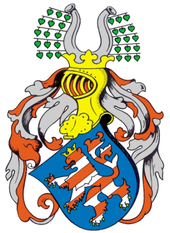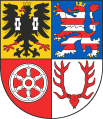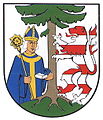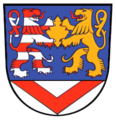Thuringian state coat of arms
The Thuringian state coat of arms shows in a blue shield the gold-armored and crowned colored lion of the Ludowingers , divided seven times by red and silver , accompanied by eight silver stars .
The Thuringian coat of arms is very similar to the Hessian one . The Hessian lion also stands in a blue field, but is divided nine times by silver and red and armed with gold. It is uncrowned and the stars are missing. The coat of arms - in contrast to that of Thuringia - is crowned by a so-called people's crown.
History of the coat of arms
As the oldest colored representation of the original Thuringian coat of arms, the coat of arms of Landgrave Konrad of Thuringia from the 13th century has been preserved. The Thuringian-Hessian War of Succession released Hesse into political independence in 1264/65, which has since had the colorful lion (reverse striped: silver-red) in its coat of arms .
The coat of arms from 1921 to 1933
The state coat of arms for the state of Thuringia was awarded on April 7, 1921. It shows seven silver stars on a red background. The seven stars stand for the seven states of Saxony-Weimar-Eisenach , Saxony-Meiningen , Saxony-Gotha , Saxony-Altenburg , Volksstaat Reuss , Schwarzburg-Sondershausen and Schwarzburg-Rudolstadt , from which the state was formed on May 1, 1920.
The coat of arms from 1933 to 1945
In 1933 a different coat of arms was introduced to the country by the National Socialist state government, because the National Socialists were bothered by the stars, which are reminiscent of Stars of David . The state coat of arms awarded by the National Socialists showed a Hessian lion in the middle (symbol of the Landgraves of Thuringia) with a swastika in the right paw, above the Saxon diamond wreath (symbol of the Ernestine regions) and the Schwarzburg eagle. The Reussian lion and the hen from the Henneberger were shown below. The structure and content of the coat of arms was based heavily on the coat of arms of the Duchy of Saxony-Coburg and Gotha and was used from 1933 to 1945. Authorities only used the heart shield as a small national coat of arms. The coat of arms was designed by the Altenburg painter Ernst Müller-Gräfe. Because of its symbolism, it was also referred to as the "Thuringian Zoo".
The coat of arms from 1945 to 1952
In July 1945 Thuringia received its third national emblem, a golden lion on a red background, now surrounded by eight silver stars. The newly added star symbolized those areas of Prussian Thuringia - the administrative district of Erfurt, which was spun off from the province of Saxony in 1944, including the district of Herrschaft Schmalkalden, which has belonged since then - which were integrated into the state in summer 1945. In 1952, the state of Thuringia and its coat of arms were abolished in the GDR .
The current coat of arms
In 1991, the description of the coat of arms of the current Thuringian coat of arms was derived from the historical basis, it is part of the law on the emblems of the state of Thuringia of January 30, 1991 . The eighth star stands for the former Prussian and formerly Hessian areas belonging to the Free State of Thuringia (including Artern , Erfurt , Mühlhausen , Nordhausen , Schmalkalden and Suhl ). The design of the coat of arms is a design by the Thuringian graphic artist Lothar Freund from 1992.
Heraldic sign
Since the original version of the coat of arms may only be used by state institutions, a modified version of the coat of arms was designed for the public who want to show ties to Thuringia .
Coat of arms gallery
- Thuringia's colorful lion
Bad Langensalza (mixed form of Hessian and Thuringian lion)
See also
literature
- Peter Hess : The Thuringian state coat of arms. (= Thuringia. Sheets on regional studies. ) Published by the State Center for Political Education Thuringia. 4th, revised edition, Erfurt 1995, 8 pages.
- Frank Boblenz : The Thuringian state coat of arms from 1921. In: Archives in Thuringia. Special edition, 1997, pp. 27–33.
- Frank Boblenz: State coat of arms, state flag and state colors. In: Thuringia Handbook. Territory, constitution, parliament, government and administration in Thuringia 1920 to 1995. (= publications from Thuringian state archives. 1). Published by Bernhard Post and Volker Wahl. Weimar 1999, ISBN 3-7400-0962-4 , pp. 190-202.
Web links
- History of the Thuringian coat of arms. In: thüringen.de.
- Steffen Raßloff : Graphic template of the state coat of arms is given to the Erfurt City Museum. In: Thuringian General . August 7, 2012.
Individual evidence
- ↑ a b The President of the State Parliament: Law on the emblems of the State of Thuringia of January 30, 1991 . In: Thüringer Landtag (Hrsg.): Law Gazette for the State of Thuringia . No. 1/1991 , January 31, 1991, pp. 1 ( thueringen.de [PDF]).















